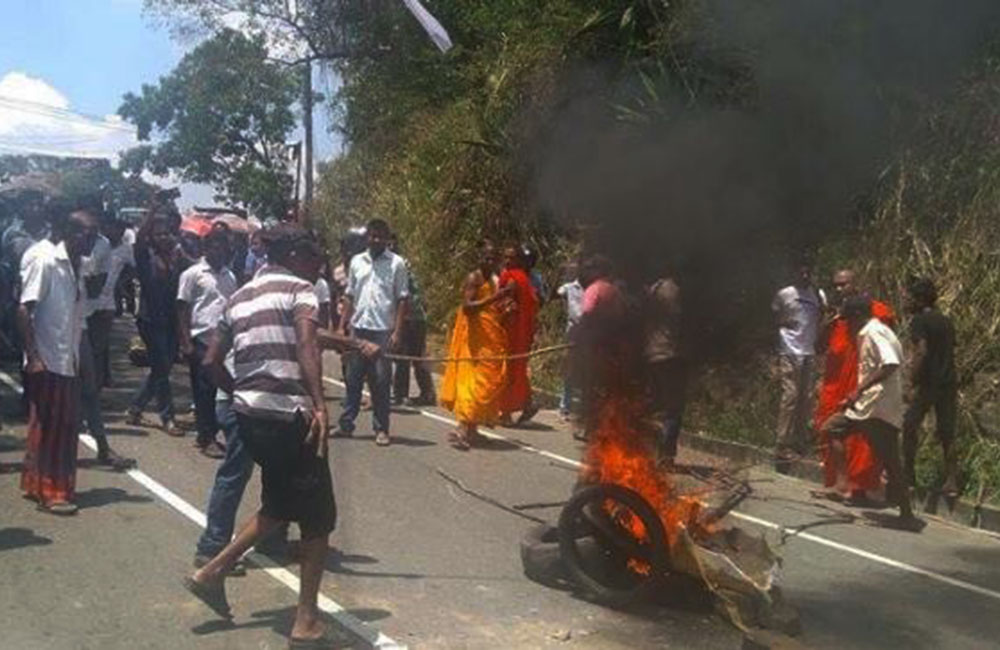Police and politicians backed by the country's former strongman president Mahinda Rajapaksa joined anti-Muslim riots that rocked Sri Lanka's Kandy district this month, according to witnesses, officials and closed-circuit television (CCTV) footage.
Scores of Muslim mosques, homes and businesses were destroyed as mobs ran amok for three days in Kandy, the central highlands district previously known for its diversity and tolerance.
The government declared a state of emergency and blocked social media platforms for a week to control the unrest. It was the first state of emergency imposed in Sri Lanka since the end of a decades-long Tamil separatist war in 2009.
The role of police and some local Buddhist politicians suggests the Sri Lankan government lost control of elements of its security forces, and that the violence was more than a spontaneous outbreak fuelled by fringe Buddhist extremists and hate-speech spread on social media.
Mr Rajapaksa has denied that he or other leaders of his party were involved. Police said the allegations against officers and politicians were being investigated.
Victims and witnesses, whose accounts were partly backed by CCTV footage, described members of an elite paramilitary police unit, the Special Task Force (STF), assaulting a Muslim cleric and leaders. Local STF commanders declined to comment.
"They came to attack," said Mr A.H. Ramees, a cleric at a mosque where worshippers say they were beaten by police who were supposed to be protecting them.
"They were shouting. There was filthy language. They said all the problems were because of us, that we were like terrorists."
Mr Ruwan Gunasekera, a spokesman for the national police force, including the STF, said a special investigation unit was "probing the deficiencies of the police in the incident". A second unit was examining the role of political actors, he said.
The riots were the latest example of rising Buddhist nationalism and anti-Muslim sentiment in the region and have unnerved Sri Lanka's multi-ethnic coalition government, which ousted Mr Rajapaksa in an election in 2015, according to analysts and two sources familiar with the government's deliberations.
Buddhists make up about 70 per cent of Sri Lanka's 21 million people. Hindus account for around 13 per cent, while Muslims make up about 9 per cent of the population.
Sri Lanka's Law and Order Minister Ranjith Madduma Bandara has said the violence in Kandy was "well organised" and pointed the finger at members of Sri Lanka Podujana Peramuna (SLPP), a political party backed by Mr Rajapaksa that scored a huge victory in local elections last month.
Flanked by senior leaders at a press conference earlier this month, Mr Rajapaksa said the accusations were politically motivated and the government instigated the violence to "get the Muslim vote" and to distract from its inadequacies.
The violence in Kandy was triggered by an attack on a Buddhist truck driver by four Muslim men after a traffic dispute on Feb 22.
As he lay in a coma, calls for retribution and anti-Islam polemics flooded social media and the government ordered the deployment of the STF. Rioting erupted after his funeral 11 days later.
An excerpt of CCTV footage from the first day of attacks showed police letting a large group of men through the cordon protecting the Noor Jummah mosque in Digana, a Kandy township.
The men rush into a multi-storey building opposite the mosque. A local SLPP politician, Mr Samantha Perera, can be seen pointing at the higher floors of the building.
Mr Perera confirmed he was the person shown in the footage. He said he was trying to calm the rioters and only found out later the mosque had been attacked.
Cabinet spokesman Rajitha Senaratne said Mr Perera was under investigation for "attacking Muslim-owned shops and mosques with stones". At least three other SLPP politicians were being investigated and another SLPP councillor has been arrested for setting fire to a mosque, he said. All deny any involvement in the violence.
REUTERS

Leave your comments
Login to post a comment
Post comment as a guest